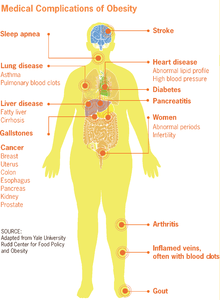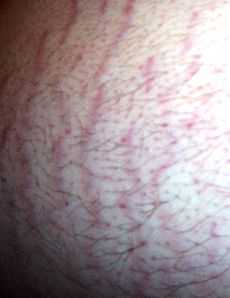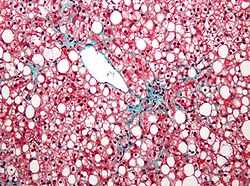Obesity-associated morbidity


Whether or not obesity should be considered a disease on its own, it is also an important risk factor for many chronic physical and mental illnesses.[1] The generally accepted view is that being overweight causes similar health problems to obesity, but to a lesser degree.
Cardiological
Ischemic heart disease
Obesity is associated with cardiovascular diseases including angina and myocardial infarction.[2][3] A 2002 report concluded that 21% of ischemic heart disease is due to obesity[1] while a 2008 European consensus puts the number at 35%.[4]
Congestive heart failure
Having a BMI greater than 30 doubles one's risk of congestive heart failure.[5][6]
High blood pressure
More than 85% of those with hypertension have a BMI greater than 25.[6] The risk of hypertension is 5 times higher in the obese as compared to those of normal weight. A definitive link between obesity and hypertension has been found using animal and clinical studies, which have suggested that there are multiple potential mechanisms for obesity-induced hypertension. These mechanisms include the activation of the sympathetic nervous system as well as the activation of the renin–angiotensin-aldosterone system.[7] The association between hypertension and obesity has been also well described in children.[8]
Abnormal cholesterol levels
Obesity is associated with increased LDL cholesterol (bad cholesterol) and lowered HDL cholesterol (good cholesterol).[6][9]
Deep vein thrombosis and pulmonary embolism
Obesity increases one's risk of venous thromboembolism by 2.3 fold.[10][11]
Dermatological

Obesity is associated with the incidence of stretch marks, acanthosis nigricans, lymphedema, cellulitis, hirsutism, and intertrigo.[12][13]
Endocrine
Diabetes mellitus
One of the strongest links between obesity and disease is that with type 2 diabetes. These two conditions are so strongly linked that researchers in the 1970s started calling it “diabesity”.[6] Excess weight is behind 64% of cases of diabetes in men and 77% of cases in women.[14]
Reproductive system
Polycystic ovarian syndrome (PCOS)
Due to its association with insulin resistance, the risk of PCOS increases with adiposity. In the US approximately 60% of patients with PCOS have a BMI greater than 30.[15]
Infertility
Obesity leads to infertility in both men and women. This is primarily due to excess estrogen interfering with normal ovulation in women[6] and altering spermatogenesis in men.[16] It is believed to cause 6% of primary infertility.[6][17] A review in 2013 came to the result that obesity increases the risk of oligospermia and azoospermia in men, with an of odds ratio 1.3.[18] Being morbidly obese increases the odds ratio to 2.0.[18]
Complications of pregnancy
Obesity is related to many complications in pregnancy including: haemorrhage, infection, increased hospital stays for the mother, and increased NICU requirements for the infant.[19] Obese women have more than twice the rate of C-sections compared to women of normal weight.[20] Obese women also have increased risk of preterm births and low birth weight infants.[21]
Birth defects
Those who are obese during pregnancy have a greater risk of have a child with a number of congenital malformations including: neural tube defects such as anencephaly and spina bifida, cardiovascular anomalies, including septal anomalies, cleft lip and palate, anorectal malformation, limb reduction anomalies, and hydrocephaly.[22]
Intrauterine fetal death
Gastrointestinal
Gastroesophageal reflux disease
Several studies have show that the frequency and severity of GERD symptoms are higher in those who are obese.[23][24]
Fatty liver disease

Cholelithiasis (gallstones)
Neurological
Stroke
Ischemic stroke is increased in both men and women who are obese.[6] For women with a BMI greater than 30, the risk of ischemic stroke increases by 1.7 fold,[25] while men with a BMI greater than 30 had a risk of stroke 2.0 times greater.[26]
Meralgia paresthetica
Migraines
Carpal tunnel syndrome
Dementia
Those who are obese have a rate of dementia 1.4 times greater than those of normal weight.[30]
Idiopathic intracranial hypertension
Multiple sclerosis
Women that are obese at age 18 have a greater than twofold increased risk of MS.[32]
Oncological
Many cancers occur at increased frequency in those who are overweight or obese. A study from the United Kingdom found that approximately 5% of cancer is due to excess weight.[33] These cancers include: [34]
- breast, ovarian
- esophageal, colorectal
- liver, pancreatic
- gallbladder, stomach
- endometrial, cervical
- prostate, kidney
- non-Hodgkin's lymphoma, multiple myeloma
Al high body mass index (BMI) is associated with a higher risk of developing ten common cancers including 41% of uterine cancers and at least 10% of gallbladder, kidney, liver and colon cancers in the UK.[35]
Psychiatric
Depression
Obesity has been associated with depression.[6] The relationship is strongest in those who are more severely obese, those who are younger, and in women.[37] Suicide rate however decreases with increased BMI.[36]
Social stigmatization
In the United States, young women who are overweight complete 0.3 year less school, are 20% less likely to get married, and make $6,710 less than their normal weight counterparts.[6][38]
Respirological
Obstructive sleep apnea
Obesity hypoventilation syndrome

Obesity hypoventilation syndrome is defined as the combination of obesity, hypoxia during sleep, and hypercapnia during the day, resulting from hypoventilation.[40] Based on its definition it occurs only in the obese.
Chronic lung disease
Obesity is associated with a number of chronic lung diseases, including asthma and COPD.[39] It is believed that a systemic pro-inflammatory state induced by some causes of obesity may contribute to airway inflammation, leading to asthma.[41]
Complications during general anaesthesia
Rheumatological and orthopedic
Gout
Compared to men with a BMI of 21–23, men with a BMI of 30–35 have 2.3 times more gout, and men with a BMI of greater than 35 have 3.0 times more gout. Weight loss decreases these risks.[43]
Poor mobility
There is a strong association between obesity and musculoskeletal pain and disability[44]
Osteoarthritis
Increased rates of arthritis are seen in both weight-bearing and non-weight-bearing joints.[6] Those with a BMI greater than 26.4 had rate of osteoarthritis of the knees 6 times greater than those with a BMI of less than 23.4, well rates of osteoarthritis in the hand was about 1.5 times greater.[45]
Low back pain
Obese individuals are twice to four times more likely to have lower back pain than their normal weight peers.[46]
Urological and nephrological
Erectile dysfunction
One third of obese men with erectile dysfunction who lose weight experience an improvement in their sexual functioning.[47]
Urinary incontinence
Urge, stress, and mixed incontinence all occur at higher rates in the obese.[48] The rates are about double that found in the normal weight population.[49] Urinary incontinence improves with weight lost.[50]
Chronic renal failure
Obesity increases one's risk of renal failure by three to four times.[51]
Hypogonadism
References
- ↑ 1.0 1.1 "Obesity and Overweight" (PDF). Fact Sheet. Global Strategy on Diet, Physical Activity and Health, World Health Organization. 2003.
- ↑ Poirier P, Giles TD, Bray GA et al. (May 2006). "Obesity and cardiovascular disease: pathophysiology, evaluation, and effect of weight loss". Arterioscler. Thromb. Vasc. Biol. 26 (5): 968–76. doi:10.1161/01.ATV.0000216787.85457.f3. PMID 16627822.
- ↑ Yusuf S, Hawken S, Ounpuu S et al. (2004). "Effect of potentially modifiable risk factors associated with myocardial infarction in 52 countries (the INTERHEART study): case-control study". Lancet 364 (9438): 937–52. doi:10.1016/S0140-6736(04)17018-9. PMID 15364185.
- ↑ Tsigos C, Hainer V, Basdevant A et al. (2008). "Management of obesity in adults: European clinical practice guidelines". Obes Facts 1 (2): 106–16. doi:10.1159/000126822. PMID 20054170. as PDF
- ↑ Kenchaiah S, Evans JC, Levy D et al. (August 2002). "Obesity and the risk of heart failure". N. Engl. J. Med. 347 (5): 305–13. doi:10.1056/NEJMoa020245. PMID 12151467.
- ↑ 6.0 6.1 6.2 6.3 6.4 6.5 6.6 6.7 6.8 6.9 6.10 6.11 6.12 6.13 Haslam DW, James WP (October 2005). "Obesity". Lancet 366 (9492): 1197–209. doi:10.1016/S0140-6736(05)67483-1. PMID 16198769.
- ↑ Rahmouni K, Correia ML, Haynes WG, Mark AL (January 2005). "Obesity-associated hypertension: new insights into mechanisms". Hypertension 45 (1): 9–14. doi:10.1161/01.HYP.0000151325.83008.b4. PMID 15583075.
- ↑ Chiolero A, Bovet P, Paradis G, Paccaud F (March 2007). "Has blood pressure increased in children in response to the obesity epidemic?". Pediatrics 119 (3): 544–53. doi:10.1542/peds.2006-2136. PMID 17332208.
- ↑ Grundy SM, Barnett JP (December 1990). "Metabolic and health complications of obesity". Dis Mon 36 (12): 641–731. PMID 2261844.
- ↑ Ageno W, Becattini C, Brighton T, Selby R, Kamphuisen PW (January 2008). "Cardiovascular risk factors and venous thromboembolism: a meta-analysis". Circulation 117 (1): 93–102. doi:10.1161/CIRCULATIONAHA.107.709204. PMID 18086925.
- ↑ Darvall KA, Sam RC, Silverman SH, Bradbury AW, Adam DJ (February 2007). "Obesity and thrombosis". Eur J Vasc Endovasc Surg 33 (2): 223–33. doi:10.1016/j.ejvs.2006.10.006. PMID 17185009.
- ↑ Yosipovitch G, DeVore A, Dawn A (June 2007). "Obesity and the skin: skin physiology and skin manifestations of obesity". J. Am. Acad. Dermatol. 56 (6): 901–16; quiz 917–20. doi:10.1016/j.jaad.2006.12.004. PMID 17504714.
- ↑ Hahler B (June 2006). "An overview of dermatological conditions commonly associated with the obese patient". Ostomy Wound Manage 52 (6): 34–6, 38, 40 passim. PMID 16799182.
- ↑ Peter G. Kopelman, Ian D. Caterson, Michael J. Stock, William H. Dietz (2005). Clinical obesity in adults and children: In Adults and Children. Blackwell. p. 493. ISBN 1-4051-1672-2.
- ↑ Azziz R, Sanchez LA, Knochenhauer ES et al. (February 2004). "Androgen excess in women: experience with over 1000 consecutive patients". J. Clin. Endocrinol. Metab. 89 (2): 453–62. doi:10.1210/jc.2003-031122. PMID 14764747.
- ↑ Hammoud AO, Gibson M, Peterson CM, Meikle AW, Carrell DT (October 2008). "Impact of male obesity on infertility: a critical review of the current literature". Fertil. Steril. 90 (4): 897–904. doi:10.1016/j.fertnstert.2008.08.026. PMID 18929048.
- ↑ 17.0 17.1 Arendas K, Qiu Q, Gruslin A (June 2008). "Obesity in pregnancy: pre-conceptional to postpartum consequences". J Obstet Gynaecol Can 30 (6): 477–88. PMID 18611299.
- ↑ 18.0 18.1 Sermondade, N.; Faure, C.; Fezeu, L. et al. (2012). "BMI in relation to sperm count: An updated systematic review and collaborative meta-analysis". Human Reproduction Update 19 (3): 221–231. doi:10.1093/humupd/dms050. PMC 3621293. PMID 23242914.
- ↑ Heslehurst N, Simpson H, Ells LJ et al. (November 2008). "The impact of maternal BMI status on pregnancy outcomes with immediate short-term obstetric resource implications: a meta-analysis". Obes Rev 9 (6): 635–83. doi:10.1111/j.1467-789X.2008.00511.x. PMID 18673307.
- ↑ Poobalan AS, Aucott LS, Gurung T, Smith WC, Bhattacharya S (January 2009). "Obesity as an independent risk factor for elective and emergency caesarean delivery in nulliparous women--systematic review and meta-analysis of cohort studies". Obes Rev 10 (1): 28–35. doi:10.1111/j.1467-789X.2008.00537.x. PMID 19021871.
- ↑ McDonald SD, Han Z, Mulla S, Beyene J (2010). "Overweight and obesity in mothers and risk of preterm birth and low birth weight infants: systematic review and meta-analyses". BMJ 341: c3428. doi:10.1136/bmj.c3428. PMC 2907482. PMID 20647282.
- ↑ Stothard KJ, Tennant PW, Bell R, Rankin J (February 2009). "Maternal overweight and obesity and the risk of congenital anomalies: a systematic review and meta-analysis". JAMA 301 (6): 636–50. doi:10.1001/jama.2009.113. PMID 19211471.
- ↑ Anand G, Katz PO (2008). "Gastroesophageal reflux disease and obesity". Rev Gastroenterol Disord 8 (4): 233–9. PMID 19107097.
- ↑ Ayazi S, Hagen JA, Chan LS et al. (August 2009). "Obesity and gastroesophageal reflux: quantifying the association between body mass index, esophageal acid exposure, and lower esophageal sphincter status in a large series of patients with reflux symptoms". J. Gastrointest. Surg. 13 (8): 1440–7. doi:10.1007/s11605-009-0930-7. PMC 2710497. PMID 19475461.
- ↑ Kurth T, Gaziano JM, Rexrode KM et al. (April 2005). "Prospective study of body mass index and risk of stroke in apparently healthy women". Circulation 111 (15): 1992–8. doi:10.1161/01.CIR.0000161822.83163.B6. PMID 15837954.
- ↑ Kurth T, Gaziano JM, Berger K et al. (2002). "Body mass index and the risk of stroke in men". Arch. Intern. Med. 162 (22): 2557–62. doi:10.1001/archinte.162.22.2557. PMID 12456227.
- ↑ Harney D, Patijn J (2007). "Meralgia paresthetica: diagnosis and management strategies". Pain Med 8 (8): 669–77. doi:10.1111/j.1526-4637.2006.00227.x. PMID 18028045.
- ↑ Bigal ME, Lipton RB (January 2008). "Obesity and chronic daily headache". Curr Pain Headache Rep 12 (1): 56–61. doi:10.1007/s11916-008-0011-8. PMID 18417025.
- ↑ Sharifi-Mollayousefi A, Yazdchi-Marandi M, Ayramlou H et al. (February 2008). "Assessment of body mass index and hand anthropometric measurements as independent risk factors for carpal tunnel syndrome". Folia Morphol. (Warsz) 67 (1): 36–42. PMID 18335412.
- ↑ Beydoun MA, Beydoun HA, Wang Y (May 2008). "Obesity and central obesity as risk factors for incident dementia and its subtypes: A systematic review and meta-analysis". Obes Rev 9 (3): 204–18. doi:10.1111/j.1467-789X.2008.00473.x. PMID 18331422.
- ↑ Wall M (March 2008). "Idiopathic intracranial hypertension (pseudotumor cerebri)". Curr Neurol Neurosci Rep 8 (2): 87–93. doi:10.1007/s11910-008-0015-0. PMID 18460275.
- ↑ Munger, KL; Chitnis, T; Ascherio, A. (2009). "Body size and risk of MS in two cohorts of US women". Neurology 73 (19): 1543–50. doi:10.1212/WNL.0b013e3181c0d6e0. PMC 2777074. PMID 19901245.
- ↑ Reeves GK, Pirie K, Beral V, Green J, Spencer E, Bull D (December 2007). "Cancer incidence and mortality in relation to body mass index in the Million Women Study: cohort study". BMJ 335 (7630): 1134. doi:10.1136/bmj.39367.495995.AE. PMC 2099519. PMID 17986716.
- ↑ Calle EE, Rodriguez C, Walker-Thurmond K, Thun MJ (April 2003). "Overweight, obesity, and mortality from cancer in a prospectively studied cohort of U.S. adults". N. Engl. J. Med. 348 (17): 1625–38. doi:10.1056/NEJMoa021423. PMID 12711737.
- ↑ Lyford, Joanna (August 2014). "Rising obesity levels in UK could result in 4,000 extra cancer cases each year". The Pharmaceutical Journal.
- ↑ 36.0 36.1 Mukamal KJ, Rimm EB, Kawachi I, O'Reilly EJ, Calle EE, Miller M (November 2009). "Body Mass Index and Risk of Suicide Among One Million US Adults". Epidemiology 21 (1): 82–6. doi:10.1097/EDE.0b013e3181c1fa2d. PMID 19907331.
- ↑ Dixon JB, Dixon ME, O'Brien PE (September 2003). "Depression in association with severe obesity: changes with weight loss". Arch. Intern. Med. 163 (17): 2058–65. doi:10.1001/archinte.163.17.2058. PMID 14504119.
- ↑ Gortmaker SL, Must A, Perrin JM, Sobol AM, Dietz WH (September 1993). "Social and economic consequences of overweight in adolescence and young adulthood". N. Engl. J. Med. 329 (14): 1008–12. doi:10.1056/NEJM199309303291406. PMID 8366901.
- ↑ 39.0 39.1 Poulain M, Doucet M, Major GC et al. (April 2006). "The effect of obesity on chronic respiratory diseases: pathophysiology and therapeutic strategies". CMAJ 174 (9): 1293–9. doi:10.1503/cmaj.051299. PMC 1435949. PMID 16636330.
- ↑ Anonymous (1999). "Sleep-related breathing disorders in adults: recommendations for syndrome definition and measurement techniques in clinical research. The Report of an American Academy of Sleep Medicine Task Force". Sleep 22 (5): 667–89. PMID 10450601.
- ↑ Sutherland ER (August 2008). "Obesity and asthma". Immunol Allergy Clin North Am 28 (3): 589–602, ix. doi:10.1016/j.iac.2008.03.003. PMC 2504765. PMID 18572109.
- ↑ Adams JP, Murphy PG (July 2000). "Obesity in anaesthesia and intensive care". Br J Anaesth 85 (1): 91–108. doi:10.1093/bja/85.1.91. PMID 10927998.
- ↑ Choi HK, Atkinson K, Karlson EW, Curhan G (April 2005). "Obesity, weight change, hypertension, diuretic use, and risk of gout in men: the health professionals follow-up study". Arch. Intern. Med. 165 (7): 742–8. doi:10.1001/archinte.165.7.742. PMID 15824292.
- ↑ Tukker A, Visscher T, Picavet H (April 2008). "Overweight and health problems of the lower extremities: osteoarthritis, pain and disability". Public Health Nutr 12 (3): 1–10. doi:10.1017/S1368980008002103. PMID 18426630.
- ↑ Hart DJ, Spector TD (February 1993). "The relationship of obesity, fat distribution and osteoarthritis in women in the general population: the Chingford Study". J. Rheumatol. 20 (2): 331–5. PMID 8474072.
- ↑ Molenaar EA, Numans ME, van Ameijden EJ, Grobbee DE (November 2008). "[Considerable comorbidity in overweight adults: results from the Utrecht Health Project]". Ned Tijdschr Geneeskd (in Dutch and Flemish) 152 (45): 2457–63. PMID 19051798.
- ↑ Esposito K, Giugliano F, Di Palo C, Giugliano G, Marfella R, D'Andrea F, D'Armiento M, Giugliano D (2004). "Effect of lifestyle changes on erectile dysfunction in obese men: A randomized controlled trial". JAMA 291 (24): 2978–84. doi:10.1001/jama.291.24.2978. PMID 15213209.
- ↑ Hunskaar S (2008). "A systematic review of overweight and obesity as risk factors and targets for clinical intervention for urinary incontinence in women". Neurourol. Urodyn. 27 (8): 749–57. doi:10.1002/nau.20635. PMID 18951445.
- ↑ Bart S, Ciangura C, Thibault F et al. (September 2008). "[Stress urinary incontinence and obesity]". Prog. Urol. (in French) 18 (8): 493–8. doi:10.1016/j.purol.2008.04.015. PMID 18760738.
- ↑ Subak LL, Wing R, West DS et al. (January 2009). "Weight loss to treat urinary incontinence in overweight and obese women". N. Engl. J. Med. 360 (5): 481–90. doi:10.1056/NEJMoa0806375. PMC 2877497. PMID 19179316.
- ↑ Ejerblad E, Fored CM, Lindblad P, Fryzek J, McLaughlin JK, Nyrén O (2006). "Obesity and risk for chronic renal failure". J. Am. Soc. Nephrol. 17 (6): 1695–702. doi:10.1681/ASN.2005060638. PMID 16641153.
- ↑ Makhsida N, Shah J, Yan G, Fisch H, Shabsigh R (September 2005). "Hypogonadism and metabolic syndrome: Implications for testosterone therapy". J. Urol. 174 (3): 827–34. doi:10.1097/01.ju.0000169490.78443.59. PMID 16093964.
